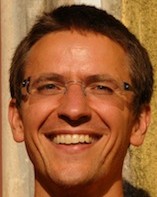The Internet of Things: Robots, RFID & Co-operation
on

Many instances of the IoT won’t even have humans in the loop. The IoT as a machine-to-machine network where sensors and actuators communicate with each other to move the environment to a desired state.
In September the workshop ROBIOTS: Robots Meet Internet of Things took place as part of the two-day PICNIC festival for media and innovation, hosted in Amsterdam. Afterwards I discussed the future of IoT, its technological challenges and its potential dark side with three of the speakers: Florian Michahelles, Heico Sandee and Stefan Gessler.The IoT experts

Dr. Florian Michahelles is the associate director of the Auto-ID Labs Zurich/St. Gallen. The Auto-ID Labs are the leading global network of seven academic research laboratories in the field of networked RFID. His research interests center around the Internet of Things.
Dr. Heico Sandee, program manager at the Department of Mechanical Engineering at Eindhoven Technical University, is specialized in control systems. He participates in the RoboEarth project, a multi-disciplinary partnership of robotics researchers from academia and industry aiming to create a world wide web for robots
Stefan Gessler is project manager at the Software and Service Research Division of NEC Laboratories Europe. He participates in the Florence project, an activity to make low-cost robots interact with a smart home environment to support elderly people in their daily life at home. He is also involved in the formation of the IoT-Forum.
The purpose of the IoT
Tessel: Why does the world need the IoT?
Florian: One answer is: it just happens. It’s just the natural evolution of technology.
Heico: It’s about span of control. I am so used to having the power at my fingertips to communicate with everyone, I find it almost stupid I can’t communicate with the things in my life. I want to be able to check on my phone whether I forgot to lock my door. I want to have access to this information and even be able to close it remotely.

Stefan: The IoT is all about co-operation and communication. Communication is a prerequisite for co-operation. You can think of thousands of scenario’s in which it is an advantage when things work together. For instance, a sensor detecting water on the bathroom floor can signal the water tap to close itself. Or a car detecting a safety hazard ahead telling the cars behind it to slow down.Heico: And it opens up entirely new possibilities. In the RoboEarth project we’re creating a system to exchange information between objects, robots and humans. Say, you connect your coffee machine to your alarm clock. As soon as the alarm goes off the machine starts making coffee. This is already possible if you have a smart coffee maker. But what if the machine runs out of coffee? This is where the robot comes in. Because it has the capability to move it can refill the coffee bean container. Robots will give arms and legs to the Internet.
And when robots are part of a network they can learn from each other. RoboEarth is building a cloud-based database which can be accessed by different kinds of robots. When a robot has solved a problem it can add this information to the cloud so that the next robot encountering the same problem can download the instructions. This way you don’t have to plan for every possible problem in the design phase of the robot, or equip them all with a large array of sensors to give them learning abilities.
Technological challenges
Tessel: What are the technological challenges of realizing the IoT?
Stefan: The biggest challenge is the modeling of information. To enable every device to communicate and to co-operate with all other devices. What happens a lot at the moment is the so called silo-approach. You have a certain application field and devices designed to execute one particular task. This system is a closed box consisting of sensors, actuators and software. If you want to add a second application you have to buy it all again, the sensors, the actuators but this time with different software and protocols. The next step we have to take is reusing the data, sharing it among the devices. But that means you need to have an interoperable interface. That is what we are working on at the moment.
Florian: At the Auto-ID labs we focus on the product side: how to make the flow of items and the supply chain more efficient. The idea is to have a barcode or uniquely identifiable RFID number that is associated with data describing the type of product. And now we recognize that the barcode –a forty year old technology- can also be useful for consumers with smartphones. But the consumer is interested in different data. He isn’t interested in the size or the weight of the product but in the ingredients or its application. And next we have to derive semantics from the data which can be interpreted by robots. In the IoT different systems that emerged for different reasons have to work together.But standardization isn’t so much a technical challenge but rather an organizational and motivational one. Because it isn’t one company providing all the infrastructure but many disparate parties. How do you get all the parties to play together? Indeed, you have the data generated by one company but what is the incentive to share? So the question really is: what is the ecosystem? What is the business case you can set up that makes the different parties willing to share because they mutually benefit from it?
Heico: I agree that interoperability is the biggest challenge but is it really such a big problem? Isn’t it a matter of making a choice and sticking to it?Stefan: It is about making a choice but in this choice you have to consider all the cases which could possibly appear.
Florian: Exactly, that’s the point. You have to understand what you need it for. Technologically it is difficult to build a solution that fits every case. So it is easier to agree on, say, five cases and get a standard on it.
Stefan: The IoT is going to develop bottom up. We will not build an IoT system and switch it on like we once did with TV technology.
Internet infrastructure
Tessel: The Internet is the backbone of the IoT. Is the current state of the Internet infrastructure sufficient?
Stefan: We will need increasingly more bandwidth. Everything is working so far but we have to be prepared for Big Data. The growth of data is exponential. As one of the speakers pointed out in the workshop: 5 billion gigabytes of data was created since the beginning of recorded time. In 2011 that same volume of data was created in two days. By 2013 we will create it in 10 minutes. The capacity of the radio spectrum is inherently limited. You can’t add an unlimited amount of devices to the wireless network.
Florian: You have to manage the scarcity. Today if the Internet is choked it may take a little longer for you to download that picture. Most of the data traffic isn’t urgent. But with the IoT it might be different. There might be health applications involved which depend on permanent access. To manage the scarcity you may have to give priority to health applications or have users pay a little fee for priority access. I think we will always be at the limits of bandwidth but I don’t think it is a showstopper for the IoT.
Stefan: On the contrary, the IoT could contribute to a more efficient organization of data traffic. It’s about making decisions as early as possible. Data relevant to a local network doesn’t need to be pushed to a remote datacenter. What we see now is two distinctions: local and the cloud. In the future we will have different layers, different levels of cloud. The data will be organized hierarchically: can it stay local, or does it have to be regionally or globally stored.
Dark side
Tessel: What are the possible dangers of this technology?

Stefan: Whenever you introduce something new it can also be used for something negative. Another thing is that a new technology always influences the way we live our lives. Many people consider changes as a threat, so we also need to care about the acceptance of IoT in future. Security, but also privacy are certainly key factors.
Florian: A possible danger is transparency. As humans we are used to understanding why things happen. With this digital component added to our world, we may not perceive the cause of occurrences with our senses anymore. That is why we continuously have to think about designing the technology in such a way that we always have a mental model to understand what is going on. It’s scary if I can’t grasp what’s happening. It means I’m controlled by something else. That’s a dark scenario. But in my opinion the worst case scenario for the Internet of Things is if it doesn’t happen.
Elektor and the IoT
As Stefan Gessler rightly points out, the IoT isn’t one technology with a single switch-on moment. Rather, it is a boundless sprawl of technologies and applications many of which are already in operation. Probably unknowingly, Elektor has already covered many of them. In the November edition alone I counted five IoT projects, proving that Elektor’s new e-departments .LABs and .MAGAZINE cover IoT without expressly identifying it. We need to work on that!
One of the best known IoT applications is the smart meter. Serving as the nerve endings of the smart (electrical) grid, smart meters provide information about power consumption at the local level enabling both energy suppliers and consumers to make informed decisions about saving energy. Last month Søren Mikkelsen showed how to install an S0-compatible electricity meter that sends detailed power consumption data to a local or cloud-based database.
In the November edition Benedikt Sauter in his series “Embedded Linux Made Easy” described how to free your Elektor Linux board from a lonely existence by setting up a network connection. And Jens Nickel introduced the C library for the ElektorBus to make it easier for developers to add microcontroller nodes. Both the Elektor Linux board and the ElektorBus are crying out to be connected to the Internet.
Also in the November 2012 edition Dr. Joost Mertens went to the very basics of internet technology when explaining how to build a network interface card (NIC) using a 8-bit AVR microcontroller. When paired with an old parallel port camera, the microcontroller allows you to send video to multiple recipients on a network.
In part 3a of the “Arduino on Course” titled ‘Connect the physical world to your Android phone’ David Cuartielles and Andreas Goransson set out to teach you how to start building your own IoT. Cheerfully continued in the December issue.


Discussion (1 comment)